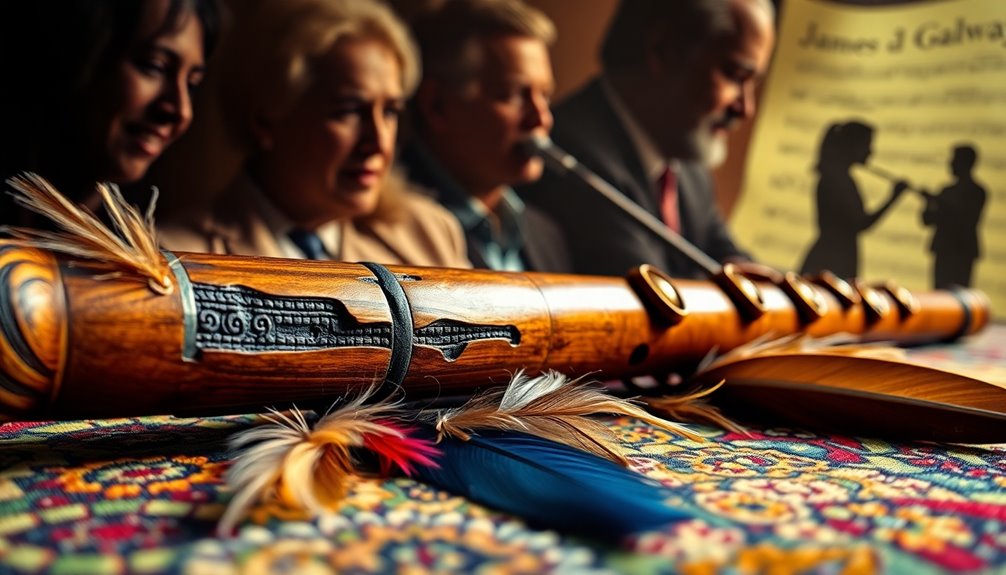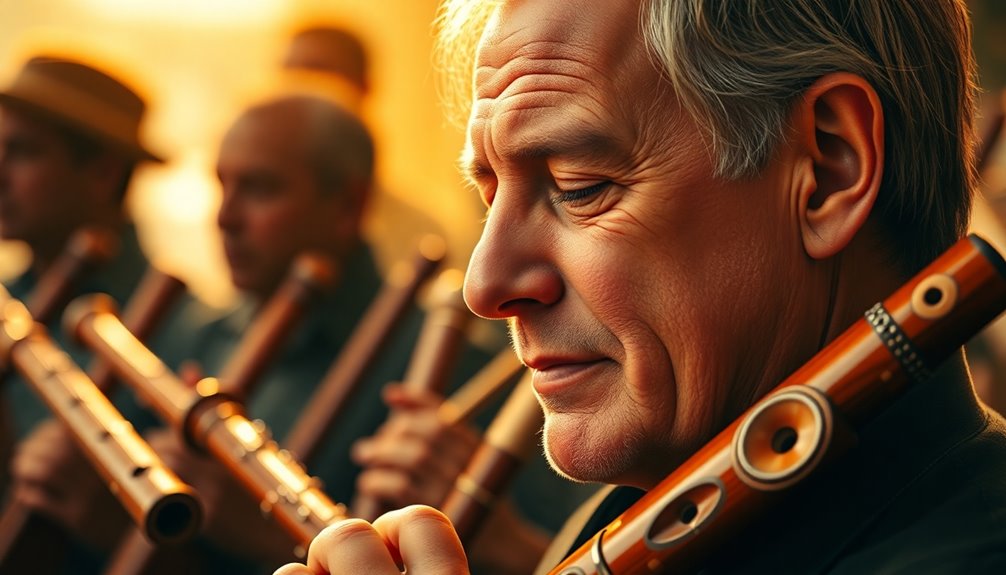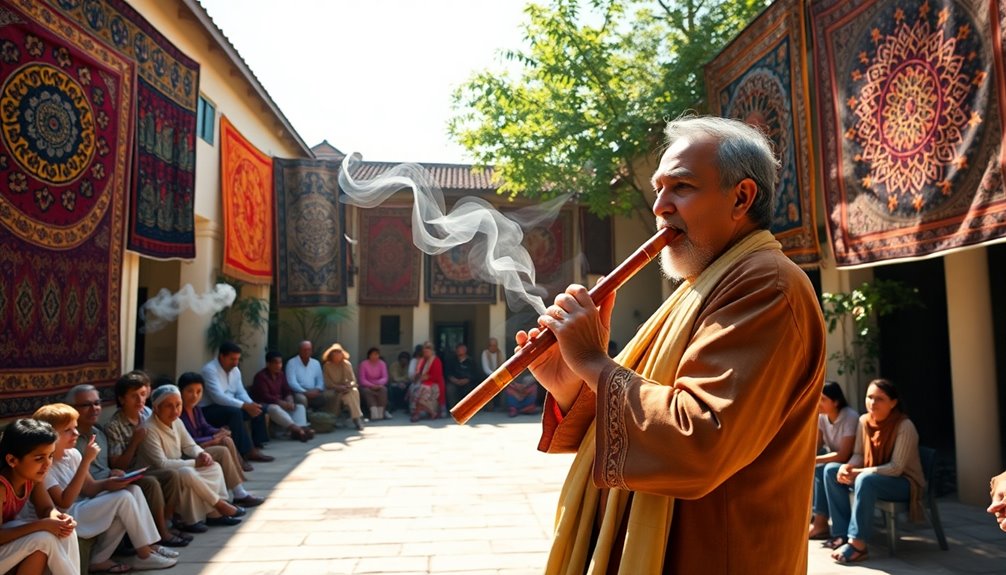Flute players like Jean-Pierre Rampal and James Galway have transformed the instrument, blending classical and contemporary styles. Nishat Khan bridges Indian classical music with modern influences, while Robert Dick challenges traditional methods, introducing techniques like multiphonics. Hariprasad Chaurasia's mastery of the bamboo flute showcases deep emotional expression, resonating globally. Julius Baker redefined flute pedagogy, focusing on emotional connections, and Rhonda Larson promotes inclusivity through diverse genres. Each artist not only advances their craft but also connects cultures through their music. There's much more to explore about their contributions and the vibrant world of flute music.
Key Takeaways
- Jean-Pierre Rampal revolutionized flute music by blending classical and contemporary styles, expanding the instrument's repertoire and audience appreciation.
- James Galway is celebrated for his enchanting performances and exceptional breath control, influencing many aspiring flutists with his expressive techniques.
- Hariprasad Chaurasia merges Indian classical music with global influences, showcasing the flute's versatility and promoting cultural interconnectedness through music.
- Robert Dick challenges traditional flute techniques, introducing multiphonics and expanding the expressive capabilities of the instrument in contemporary compositions.
- Nishat Khan bridges classical Indian music and modern styles, enhancing the flute's tonal quality through innovative improvisation and educational mentorship.
Jean-Pierre Rampal

Jean-Pierre Rampal, often hailed as one of the greatest flutists of the 20th century, transformed the way audiences perceive the flute. His pioneering spirit and innovative flute techniques not only elevated the instrument's status but also made it more accessible to a broader audience. You can see how Rampal's legacy continues to resonate today, inspiring countless flutists around the world to explore new sounds and styles.
Rampal's approach to performance was characterized by a unique blend of technical mastery and emotional expressiveness. He emphasized the importance of tone production, vibrato, and phrasing, which are fundamental to developing a distinctive sound. You might find it fascinating how he effortlessly combined classical and contemporary repertoire, breaking down barriers between genres. This versatility opened doors for flutists, encouraging them to experiment with their own interpretations.
Moreover, Rampal was dedicated to expanding the flute repertoire. He commissioned numerous works from contemporary composers, thereby enriching the musical landscape and ensuring that the flute remained a vibrant part of the classical tradition. His recordings are a treasure trove for both aspiring and seasoned flutists, showcasing a wide range of techniques and styles that you can learn from. This commitment to traditional flute melodies highlights the emotional depth and cultural significance embedded in the music he championed.
In essence, Rampal's legacy isn't just about his remarkable achievements; it's about his influence on how the flute is perceived and played. By embracing his innovative flute techniques, you're participating in a rich tradition that continues to evolve, fostering a sense of belonging within the global community of flute players.
James Galway

One could argue that James Galway is a defining figure in the world of flute playing, renowned for his enchanting performances and exceptional technique. His mastery of the flute transcends borders, making him a beloved musician across various cultures. You can appreciate how his unique Galway techniques have revolutionized flute playing, blending classical elegance with a touch of modern flair.
Galway's collaborations further highlight his versatility and commitment to musical exploration. He's partnered with a diverse array of artists, enriching the musical landscape and inviting audiences to experience the flute in innovative ways. This synergy of talent not only enhances his own artistry but also fosters a sense of community among musicians and listeners alike.
Here's a quick glance at Galway's contributions:
| Aspect | Details | Impact |
|---|---|---|
| Galway Techniques | Unique breath control and phrasing | Elevates flute expression |
| Galway Collaborations | Collaborations with pop and classical artists | Broadens audience reach |
| Notable Performances | Concerts worldwide, including festivals | Inspires future generations |
Through his enchanting performances and dynamic collaborations, James Galway has become a beacon of inspiration for flutists and music lovers. You can see how his influence extends beyond mere technique; it's about the joy of music and the connections it creates. His commitment to mastering breath control techniques enhances not only his performances but also serves as a model for aspiring flutists. Whether you're a seasoned flutist or a casual listener, Galway's artistry invites you to be part of a vibrant musical journey.
Nishat Khan

With a remarkable blend of tradition and innovation, Nishat Khan stands out as a pioneering figure in the world of flute music. You can truly appreciate how his unique approach bridges the gap between classical Indian music and contemporary styles. Nishat Khan's heritage, rooted in a lineage of renowned musicians, profoundly influences his artistry. He draws upon the rich history of Indian classical music while seamlessly integrating modern elements, creating a distinctive sound that resonates with diverse audiences.
Nishat Khan's techniques are equally remarkable. He employs a variety of playing styles and breath control methods that not only enhance the flute's tonal quality but also evoke deep emotions. His mastery of improvisation allows him to explore the flute's capabilities in real-time, enchanting listeners with spontaneous creations. You might find that his performances often reflect a deep spiritual connection, inviting you to share in a collective experience that transcends cultural boundaries.
Moreover, his commitment to education and mentorship helps foster a new generation of flutists. By sharing his knowledge and insights, Nishat Khan cultivates a sense of belonging among aspiring musicians. You can see his influence not just in concert halls but also in the vibrant communities that form around his teachings. As a versatile instrument, the flute has a significant role in various musical expressions across genres, allowing musicians like Khan to expand their creative horizons.
As you explore his music, you'll discover how Nishat Khan embodies the spirit of collaboration and innovation, making him a significant force in the evolution of flute music today.
Robert Dick

How does Robert Dick redefine the possibilities of the flute? You'll find that his approach challenges traditional playing methods, pushing the boundaries of what the instrument can achieve. With his innovative techniques, Dick expands your understanding of flute music, blending classical traditions with modern experimentation.
He's not just a player; he's a pioneer who's carved out a unique space in the contemporary music scene. One of his significant contributions is the development of multiphonics, allowing flutists to produce multiple notes simultaneously. This technique adds rich textures and layers to compositions, transforming the flute from a solo instrument into a complex voice within an ensemble.
You might be surprised at how this alters the harmonic landscape, inviting listeners into a deeper auditory experience. His contemporary compositions often incorporate these techniques, creating pieces that resonate with both emotional depth and technical prowess. Works like "Glissando" showcase his ability to meld innovative sound with expressive melodies, inviting you to explore new dimensions of flute music.
Moreover, Dick's dedication to education guarantees that these techniques aren't just reserved for elite flutists. He actively shares his knowledge through workshops and masterclasses, fostering a sense of community among aspiring musicians. This commitment to accessibility reinforces the idea that the flute, in all its forms, belongs to everyone. As you delve into his work, you'll notice that he emphasizes the importance of airflow control, which is crucial for achieving clarity in multiphonics.
So, as you explore Robert Dick's world, you'll discover not just a musician, but a transformative force that connects you to a vibrant musical community.
Hariprasad Chaurasia

Hariprasad Chaurasia stands as a monumental figure in the world of Indian classical music, particularly known for his mastery of the bamboo flute, or bansuri. His ability to evoke a range of emotions through his playing not only showcases his technical skill but also reflects the deep cultural roots of Indian classical traditions.
You can feel the weight of history in each note he plays, transporting you to a world where music transcends boundaries.
Chaurasia's influence extends beyond traditional Indian classical music. He's a pioneer of musical fusion, collaborating with a variety of artists across genres. By blending Indian classical elements with Western music, he's created a unique sound that resonates with diverse audiences.
You might find yourself captivated by how he weaves intricate ragas with contemporary rhythms, making his performances accessible to both classical purists and newcomers alike.
His journey, marked by dedication and passion, is a demonstration of the power of music as a universal language. When you listen to Chaurasia, you're not just hearing notes; you're experiencing a rich tapestry of cultural expression.
His work encourages you to explore the beauty of musical fusion, inviting you to appreciate the interconnectedness of different musical traditions. Incorporating techniques such as diaphragmatic breathing can further enhance a wind player's performance by improving sound quality and lung capacity.
In an era where cultural boundaries often blur, Hariprasad Chaurasia's contributions remind you that music can unite us all, fostering a sense of belonging through shared experiences and emotions.
His artistry continues to inspire, urging you to embrace the magic of music in all its forms.
Julius Baker

Julius Baker is often regarded as one of the most influential flute players of the 20th century, known for his exceptional technique and innovative approach to the instrument.
You might find it intriguing how Baker's techniques not only shaped his playing style but also influenced generations of flutists who followed in his footsteps. His commitment to teaching and performance left a lasting mark on the flute community.
Baker was particularly known for:
- A unique sound that combined warmth and clarity, enchanting audiences.
- Innovative breathing techniques that allowed for greater control and expression.
- Focus on intonation, which elevated the quality of ensemble playing.
- Mentorship, guiding countless students, many of whom became prominent musicians themselves.
Baker's legacy extends far beyond his remarkable performances.
He revolutionized flute pedagogy, emphasizing not just technical skills but also the emotional connection to music. His use of diaphragmatic breathing techniques further enhanced his students' ability to achieve rich, resonant tones.
You can truly appreciate how his holistic approach fostered a sense of belonging among his students, encouraging them to find their own voices.
Rhonda Larson

Building on the legacy of pioneering flutists like Julius Baker, Rhonda Larson has carved out her own niche in the world of flute performance and education. You may find her work particularly inspiring, as she blends traditional techniques with innovative approaches that resonate across cultures.
Rhonda Larson's techniques are multifaceted; her emphasis on breath control and resonance allows flutists to explore the instrument's full potential while maintaining emotional expression. Mastery of breath control techniques is essential for unlocking the flute's expressive capabilities.
Larson's influence extends beyond her technical prowess. As a dedicated educator, she cultivates a sense of community among her students, encouraging them to embrace their unique voices. You might appreciate how she encourages exploration within diverse musical genres, from classical to folk. This openness not only enriches the learning experience but also fosters a deep sense of belonging among her students.
Moreover, Larson's collaborations with artists from various cultural backgrounds highlight her commitment to inclusivity in music. By bridging gaps between different styles, she showcases the flute's versatility, inviting listeners to engage with a broader spectrum of sounds.
You can see how her work reflects a vision of a united musical community, where every voice matters.
Frequently Asked Questions
What Are the Main Types of Flutes Used Worldwide?
When exploring the main types of flutes worldwide, you'll encounter several fascinating options.
The bamboo flute offers a warm, earthy sound, while the concert flute shines in orchestras with its silver tone.
The piccolo flute, smaller and higher-pitched, adds brightness to music.
You can't overlook the Native American flute, known for its soulful melodies.
The transverse flute, played sideways, and the recorder flute, perfect for beginners, round out this diverse family of instruments.
How Do Cultural Backgrounds Influence Flute Playing Techniques?
Cultural backgrounds dramatically shape flute playing techniques, almost like the magical brushstrokes of a masterpiece!
You'll find that traditional styles vary immensely, influencing everything from breath control to finger positioning.
For instance, in some cultures, you might notice intricate embellishments that tell stories, while in others, rhythms pulsate like heartbeats.
What Are Common Challenges Faced by Flute Players?
As a flute player, you'll likely face challenges like breath control and finger coordination.
Mastering breath control is essential for producing a consistent tone, while finger coordination affects your ability to play smoothly and accurately.
You might struggle with shifting between notes, especially during fast passages.
Embracing these challenges can strengthen your skills and deepen your connection to the instrument, fostering a sense of belonging within the musical community.
Keep practicing, and you'll see improvement!
Are There Any Famous Flute Compositions or Pieces?
Did you know that over 2,000 flute compositions exist in classical music? Among the most famous flute pieces are Mozart's Flute Concerto No. 1 and Bach's Partita in A minor.
These classical flute compositions showcase the instrument's versatility and beauty. Exploring these works not only deepens your appreciation for the flute but also connects you with a rich tradition of music that many share and celebrate.
How Can One Learn to Play the Flute Effectively?
To learn the flute effectively, you should focus on consistent practice techniques.
Start with warm-ups and scales to build your foundation. Utilize online resources, like video tutorials and interactive lessons, to supplement your practice.
Joining a community, whether online or in-person, can also provide support and motivation.
Conclusion
As you explore the legacies of these seven influential flute players, you might find yourself captivated by their unique styles and cultural impacts. Each musician, from Rampal's classical finesse to Chaurasia's mystical Indian melodies, exposes a world of sound that challenges your perceptions of the flute. But what if their stories intertwine in unexpected ways? Dive deeper, and you might discover the hidden connections that elevate their artistry, revealing a rich tapestry of influence across cultures.






